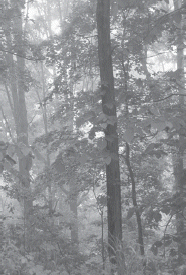Green Horizons
Volume 11, Number 3Summer 2007
Kirk Fine and David Watson, Financial Planners and Missouri Tree Farmers
 |
Woodland owners are often so focused on the day-to-day tasks of managing their forest – timber stand improvement (TSI), pruning, tree planting, timber sales (the fun stuff) – they often do not have a clear vision of where they want to take their property in the long run. As important as activities such as TSI are to the future of our woodlands, it may be more important to have a crystal clear picture of what we are building during our lifetimes, and after. We wouldn’t begin a long trip without a clear idea of where we want to go, and we shouldn’t manage our woodlands that way either… A vision statement is the answer.
A vision statement should be a statement about our dreams. It should capture the essence of our desire for the woodlands that are so important to us. It should be clear and concise. A vision statement does NOT contain specific objectives or strategies nor does it tell how we are going to get there. It simply states where we want to go. It defines why we are in this business, or why we own this woodland. A vision statement becomes a compass.
Examples of a properly designed vision statement could be:
- To provide hunting and recreational opportunities to our children and their families;
- To maximize the long-term revenue potential of the timber resources for current and future generations of our family;
- To grow and harvest high-quality black walnut timber in a sustainable manner.
A properly constructed vision statement should frame the owner’s ultimate goal for the benefit of anyone making decisions regarding the tree farm now, or in the future. It is the beginning of the blueprint for the operating decisions, as well as the estate planning decisions, later on.
Once a vision statement is in place, goals can be identified. For example, a goal for our vision of maximizing the longterm revenue potential of the timber resources could be:
- To implement timber management practices that produce sustainable long-term revenues.
As we become more focused, specific objectives flow easily:
- Conduct a timber inventory this winter;
- Conduct TSI on stands 1, 2 and 3 next year;
- Conduct a professionally managed timber sale on stands 4 and 5 in the next five years;
- Establish a properly designed trust to manage the farm when we are unable to do so.
 |
It would be easy for this couple to lose their way, unless they are able to keep their eye on the big picture – on what is most important to them. In other words, it would be easy to get lost in the forest, by focusing only on the trees! However, a properly designed vision statement could provide the high-altitude perspective they need to stay on track. It should keep them focused on the ultimate goal, and allow them to sort through the various choices in front of them, selecting the ones that best accomplish their vision.
Hundreds of thousands of acres in this state alone are destined to change hands in the next two decades as the current generation of owners ages and needs to hand the reigns over to the next generation of their family.
These children and grandchildren, many times, have different perspectives and different skill sets than the current owners. This makes the task of transferring the tree farm or woodland, in the manner the owner wishes to transfer it, more difficult. The ultimate success of this ownership transfer is crucial to the future of our great woodlands, and it hinges on successfully communicating and transferring the owner’s vision, first.
So, how clear is your vision?
| Need Help Seeing Your Forest for the Trees? Remember… Woodland Steward is now available online! This program is a great way to learn basic forest and wildlife management concepts and integrate them in a management plan that will help your vision come to life! Check it out at www.cdis.missouri.edu. |